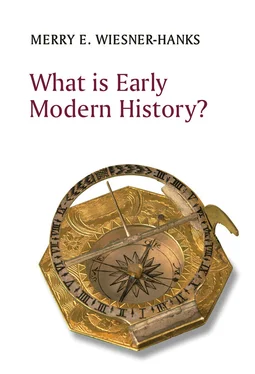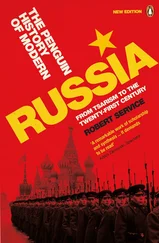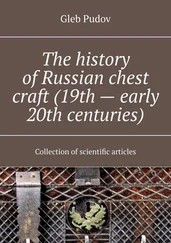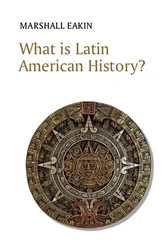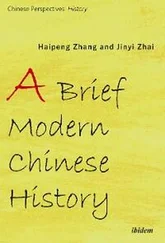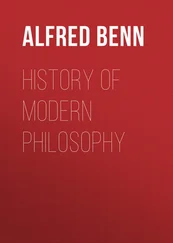Merry E. Wiesner-Hanks - What is Early Modern History?
Здесь есть возможность читать онлайн «Merry E. Wiesner-Hanks - What is Early Modern History?» — ознакомительный отрывок электронной книги совершенно бесплатно, а после прочтения отрывка купить полную версию. В некоторых случаях можно слушать аудио, скачать через торрент в формате fb2 и присутствует краткое содержание. Жанр: unrecognised, на английском языке. Описание произведения, (предисловие) а так же отзывы посетителей доступны на портале библиотеки ЛибКат.
- Название:What is Early Modern History?
- Автор:
- Жанр:
- Год:неизвестен
- ISBN:нет данных
- Рейтинг книги:5 / 5. Голосов: 1
-
Избранное:Добавить в избранное
- Отзывы:
-
Ваша оценка:
- 100
- 1
- 2
- 3
- 4
- 5
What is Early Modern History?: краткое содержание, описание и аннотация
Предлагаем к чтению аннотацию, описание, краткое содержание или предисловие (зависит от того, что написал сам автор книги «What is Early Modern History?»). Если вы не нашли необходимую информацию о книге — напишите в комментариях, мы постараемся отыскать её.
What is Early Modern History?
What is Early Modern History? — читать онлайн ознакомительный отрывок
Ниже представлен текст книги, разбитый по страницам. Система сохранения места последней прочитанной страницы, позволяет с удобством читать онлайн бесплатно книгу «What is Early Modern History?», без необходимости каждый раз заново искать на чём Вы остановились. Поставьте закладку, и сможете в любой момент перейти на страницу, на которой закончили чтение.
Интервал:
Закладка:
Each of these journals and organizations defines the period slightly differently: The Sixteenth Century Journal as roughly 1450 to 1660, Early Modern Literary Studies as 1500 to 1700, Early Modern Women as 1400 to 1700, the Journal for Early Modern Cultural Studies as roughly 1550 to 1850, and the Journal of Early Modern History as even longer, roughly 1300 to 1800. The varying definitions of the period reflect the perspectives and aims of scholars and editors, but also reconceptualizations of the field. In the nineteenth century and for most of the twentieth, the break between medieval and modern was seen as 1500, with Columbus and Luther the most important figures. In most recent research and teaching materials, it has moved backward at least to 1450, to take into account the invention of printing with movable metal type, the effective use of gunpowder weaponry, the conquest of Constantinople by the Ottomans, and the earliest European voyages down the African coast. In a few cases it has moved still further backward, fully encompassing the Renaissance in Europe and the end of the Mongol Empire in Asia. Thus in this longer periodization the Renaissance is once again seen as part of the modern era and not a bridge period.
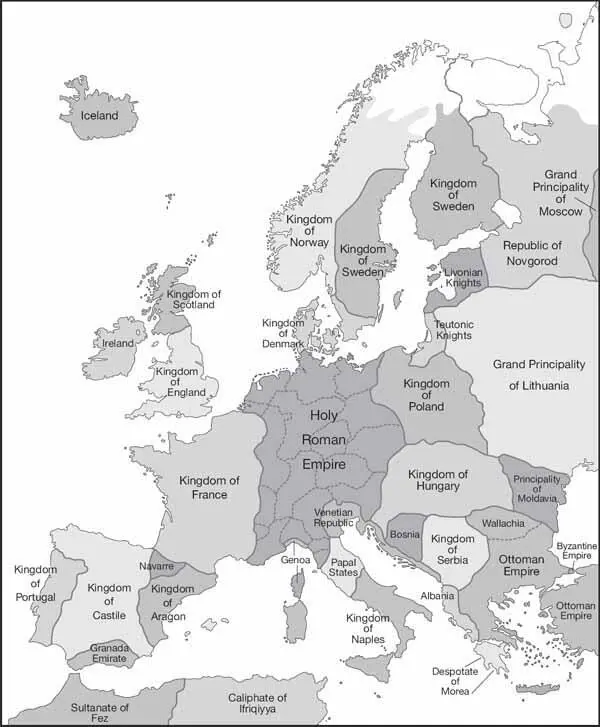
Map 1: Europe in 1450
The end of the early modern era tends to vary by discipline. In literature, especially in the English literature that dominates the field, it is generally set at around 1700. In history, it is almost always 1789 or 1800. The former date, that of the French Revolution, privileges the political history of western Europe, though there were other significant changes in the decade: Edmund Cartwright invented the steam-powered loom and opened the first cloth-making factory using his new machines, and the first fleet of convicts set sail from Britain to Australia, carrying about a thousand people. Thus the 1780s saw new processes in industrialization and colonization, two developments that are markers in most literature of the break between “early modern” and what we might call “truly modern.” In his influential The Birth of the Modern World, 1780–1914 , for example, Christopher Bayly begins with that decade. 9But 1800 works just as well to mark this break, and is widely used.
Disputing “early modern”
At the same time that “early modern” swept the academic landscape, there were also critiques and disputes. Some of these were about continuities. The voyages of Columbus may have marked the beginning of intensive European exploration and colonization, but there was plenty of earlier contact between Europeans and other cultures, and Columbus himself was motivated more by religious zeal – generally regarded as “medieval” – than by a “modern” desire to explore the unknown. 10The Protestant Reformation did bring a major break in western Christianity, but Martin Luther was seeking to reform the church, not split it, just like medieval reformers, of which there were many. Other developments traditionally regarded as marks of modernity, such as the expansion of capitalism, the growth of the nation-state, or increasing interest in science and technology, were also brought into question as scholars found both earlier precedents and evidence that these changes were slow in coming. Though many Anglophone followers of the Annales school called themselves “early modernists,” Annalistes themselves saw no dramatic break, but posited a longue dur é e stretching from the eleventh century to the nineteenth, a period the French historian and Annaliste Emmanuel Le Roy Ladurie termed “motionless.” 11The French medieval historian Jacques Le Goff argues for a “long Middle Ages” that saw a number of “renaissances,” and that lasted until the mid eighteenth century, when industrialization allowed people to “leave one period behind and leap forward to the next.” 12Among women’s historians, Judith Bennett used examples from women’s work experiences and other areas of life to challenge what she termed the “assumption of a dramatic change in women’s lives between 1300 and 1700.” 13
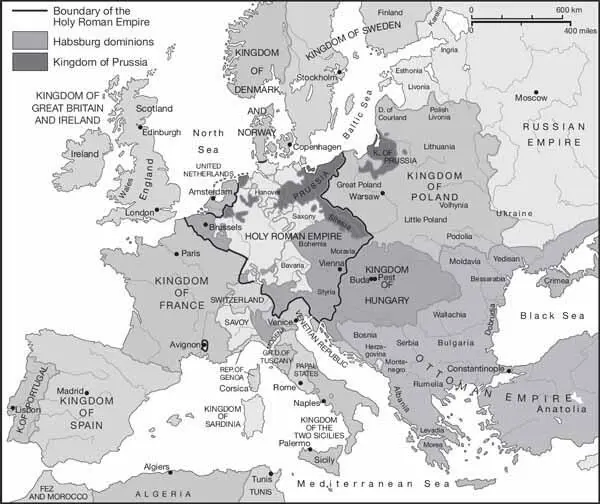
Map 2: Europe in 1763
Other debates have revolved around the whole idea of modernity. Not only was “Renaissance” value laden, but so was “modern.” The humanist historians who first thought of themselves as “new” saw this as a good thing, as did the eighteenth-century philosophers who created the Enlightenment and saw themselves as “moderns” racing toward the future. Most of the social and political theorists of the nineteenth and twentieth centuries who developed theories about the progress of history, such as Karl Marx, Max Weber, and Émile Durkheim, saw this as beneficial or inevitable.
More recent commentators have not necessarily agreed. As concepts, “modernity” and “modernization” are teleological and totalizing, implying that history developed on a single linear trajectory with a final act. Over the last fifty years, master narratives of all types, including a single path to modernity, have come into question. 14Scholars of medieval literature have sharply critiqued what Lee Patterson termed the “crude binarism that locates modernity (‘us’) on one side and premodernity (‘them’) on the other,” a binarism Kathleen Davies links to ideas about secularization, in which the Middle Ages are seen as trapped in theology. 15The historian of early modern England Garthine Walker has similarly highlighted problems with modernization theory, which generally contrasts “traditional” and “modern,” because “societies are far too variable to be captured in a simple dichotomy” and “meaning arises not from the movement of history, but from the social and cultural beliefs and actions of human beings in a given context.” 16Scholars have also pointed to issues specifically with the notion of early modern, which suggests that this era is best understood as on the way to somewhere else but not quite there yet. J.H. Elliott, for example, notes that the term “runs the risk of suggesting that the period is no more than a staging-post on the road to contemporary society.” 17In an article titled “the early modern muddle,” the historian of Italy Randolph Starn comments that the term is “saddled with a teleological modernizing directory,” and “formed by the backfill from the debris of the collapsed breakthroughs to modernity that had not (quite) come about.” 18
“Modernity” was (and often is) also explicitly or implicitly western, and connected with colonial domination. 19Reflecting sentiments that are widely shared, the historians of Southeast Asia Leonard and Barbara Andaya comment, “especially in light of subaltern writings that reject the notion of modernity as a universal … the very invocation of the word implicitly sets a ‘modern Europe’ against a ‘yet-to-be modernized’ non-Europe.” 20The world beyond Europe joins the Middle Ages as a “them” as compared to “us,” consigned to what the historian of South Asia Dipesh Chakrabarti calls the “waiting room of history,” on the same path but not arrived. 21Such critiques mean that scholars of areas outside of Europe who use “early modern” have tended to explain their use of the term more than those who focus on Europe do. (For more on scholarship on areas outside of Europe, see Chapters 4and 5.) More philosophical issues also emerged: What exactly do we mean by “modernity”? Will it ever end? Has it ended? What comes afterward?
Читать дальшеИнтервал:
Закладка:
Похожие книги на «What is Early Modern History?»
Представляем Вашему вниманию похожие книги на «What is Early Modern History?» списком для выбора. Мы отобрали схожую по названию и смыслу литературу в надежде предоставить читателям больше вариантов отыскать новые, интересные, ещё непрочитанные произведения.
Обсуждение, отзывы о книге «What is Early Modern History?» и просто собственные мнения читателей. Оставьте ваши комментарии, напишите, что Вы думаете о произведении, его смысле или главных героях. Укажите что конкретно понравилось, а что нет, и почему Вы так считаете.
